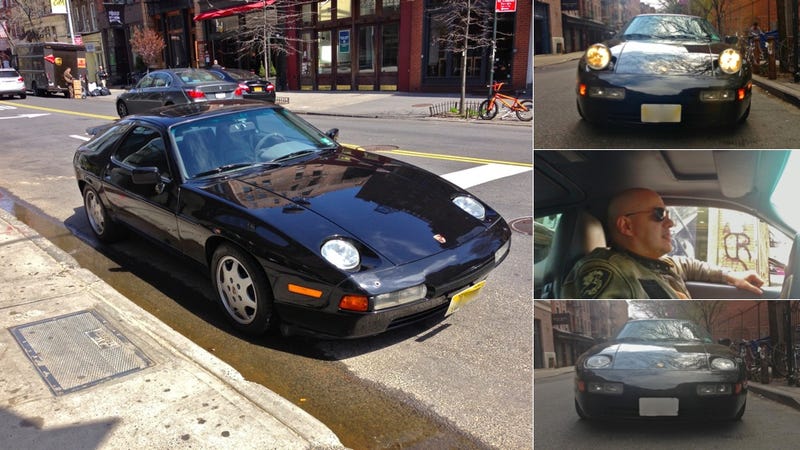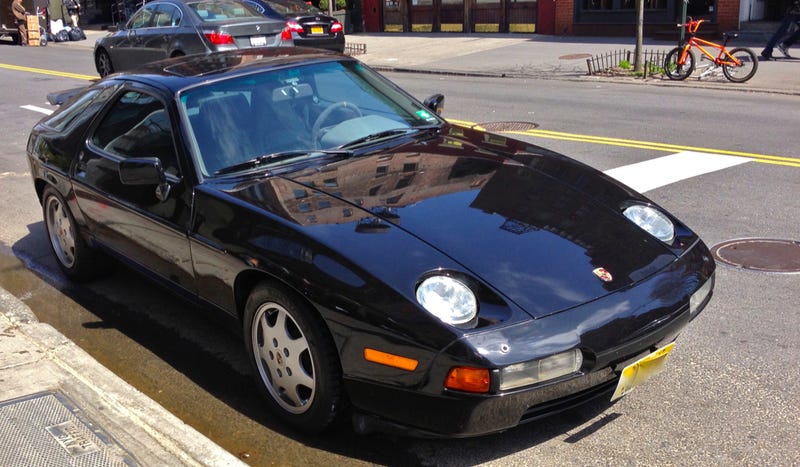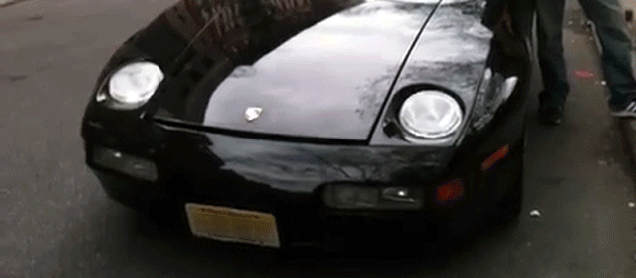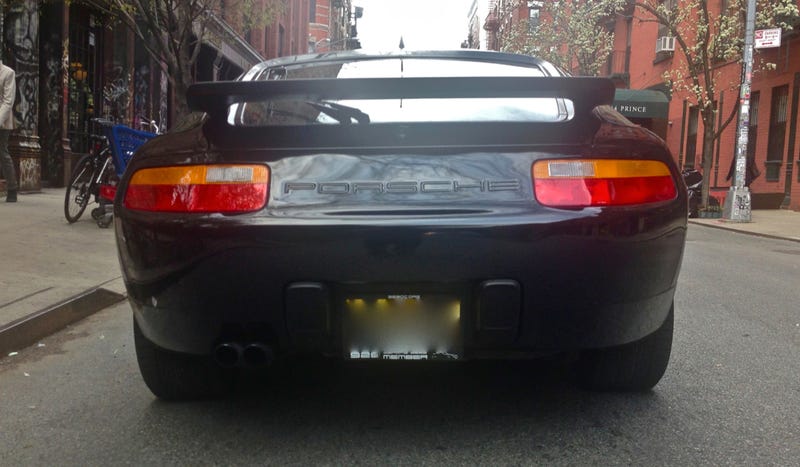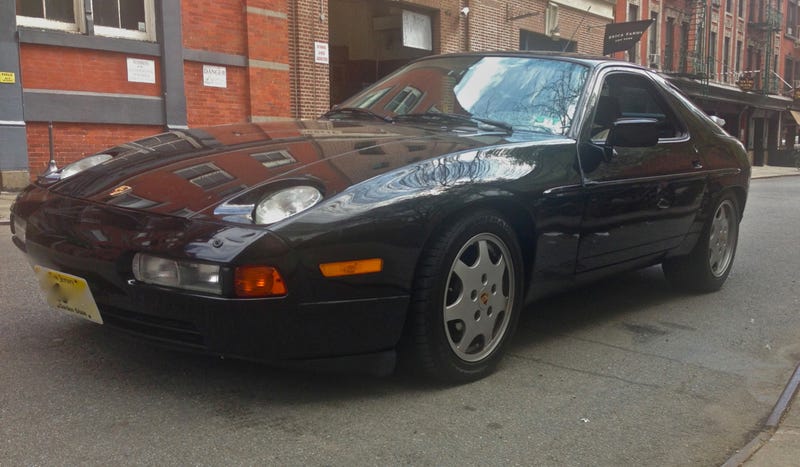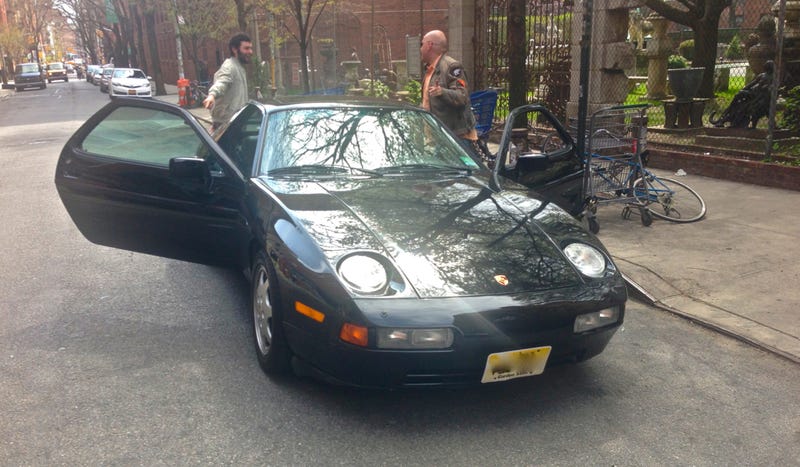As the 1970s unfolded, both Porsche and Ferrari found themselves at a crossroads. At Porsche, the issue was particularly urgent: The time had come to design the eventual replacement for the 911, the bread-and-butter car that was heir to the Zuffenhausen firm's glorious sporting history. Meanwhile, 230 miles to the south in Maranello, Ferrari was wrestling with the challenge of building a successor to the beautiful and beloved Dino 246.
Two very different carmakers, two very different sets of challenges. Yet the bold new designs that resulted were in many ways similar, and promised to change the course of both manufacturers' fortunes. For Ferrari, it was the 308, the first V-8-powered road car to roll out of Maranello bearing the company's name. For Porsche, it was the 928, a two-plus-two coupe that threw decades of tradition out the window with its water-cooled, front-mounted V-8, the company's first. Both promised hedonistic levels of luxury and performance for those who could write the sizable check. But only one would lead the way to the future.
The 928 had been under development for six years when it was unveiled at the 1977 Geneva Motor Show. As an automobile, the 928 was a fine piece of engineering; as a Porsche, it was heresy on wheels. Starting with a blank sheet of paper, Porsche's engineers had come up with something as un-911 as possible. Porsche's daring was rewarded with critical acclaim, including European Car of the Year honors in 1978. It was the first time a sports car had been so honored.
The 928 was born as Porsche was going through a transition, with the arrival of a new chief executive, Ernst Fuhrmann. Fuhrmann, who was responsible for the design of the Carrera engine in the 1950s, believed that the time had come for a front-engined grand tourer to appeal to American tastes. A shift to water cooling, it was thought, would help the car meet America's ever-tightening emissions standards.
The powerplant Porsche developed for its new flagship was a beauty: a 4,474cc, 16-valve, single overhead-cam V-8 with a linerless alloy block and alloy heads that produced 219hp in U.S. trim. The engine was equipped with the Bosch K-Jetronic fuel injection system, often referred to as a continuous injection system or CIS. Delivering the power to the rear wheels was either a five-speed transaxle or (more often) an optional automatic sourced from Mercedes-Benz. At the rear was the innovative Weissach axle, which counteracted any tendencies to oversteer through a linkage designed to induce a kind of passive rear-wheel steering.
All of that sophisticated machinery was wrapped in a smooth hatchback body designed in-house by Anatole Lapine. The majority of the body was steel, with aluminum used for the doors, hood and front fenders; there was a substantial luggage compartment in the rear, and a wide and deep cabin where two passengers could stretch out in comfort. Two children or very small adults could be squeezed into the vestigial rear seats for short periods.
Lapine favored unadorned designs-"When little kids draw a car, they draw a beetle. When little kids draw a fast car, they draw a flattened beetle with a big exhaust pipe: in other words, a Porsche. That's how simple and archetypal good design is," he once said-and the 928 was a distinctive design that borrowed almost nothing from Porsches that had gone before. Poly-urethane nose and tail sections that bounced back on impact gave the car the appearance of having no bumpers, and skyward-gazing, pop-up headlamps-supposedly based on the Lamborghini Miura-lent the car its nickname, the "shark" or "land shark."
Priced at $28,500, about 50 percent more than a 911, the 928 took its place in Porsche's range alongside the 911SC, the 930 Turbo, and the 924-which, although it was the first front-engine Porsche on the market, actually followed the 928 on the drawing board. The luxury coupe went through a number of changes during its 18 years in production, its engine becoming larger and more potent. As the fuel crisis of the mid-1970s faded, Porsche introduced the 928S, with a 4.7-liter, 234hp V-8 engine that pushed the car toward the 150mph barrier. There followed the Series 3 S, with a four-valve, quad-cam engine making 288hp; the 4,957cc, 316hp S4; the GT with its revised, 326hp engine; and the ultimate 928, the GTS, its 5,400cc, 345hp engine being the most powerful to reside under that sloping hood.
By the time the 928 was shunted aside to make room for the new Boxster in 1995, production, which had been in a steady decline, amounted to 61,221 cars, with two in five going to the United States. The car that was to have succeeded the 911 had instead become a blind alley. Why? In his book
Porsche: Excellence Was Expected: The Comprehensive History of the Company, its Cars and its Racing Heritage, Karl Ludvigsen writes that "L. J. K. Setright-an admirer of the original 928, which he felt 'deserved to be considered the best car in the world'-judged that Porsche had willfully wrong-slotted the subsequent path of development of its V-8. During the Schutz years of the 1980s, he wrote, 'an equally wealthy and more tasteless class of customers began to clamor for the glamour of association with sporting competition. Sadly, Porsche was only too ready to accommodate them and the 928 deteriorated rapidly as it was developed in succeeding versions, each of which was successively more sporting, more powerful, more noisy, more harsh than the previous one.' In Setright's view the 928 became 'steadily less gentlemanly, less useful, less convincing, until finally the customers so lacked conviction that production faltered to a halt in 1995.'
"A Porsche insider, Peter Falk, begged to differ," Ludvigsen writes. "'The last 928 was a really outstanding car,' he said, but in the same breath admitted that 'we didn't have the same heart for these cars as for the 911.' Working on the 928 was a duty, not a pleasure, for the Weissach engineers. Good though it was, the eight never rivaled the affection that they and their customers felt for the more demanding and-just for that reason-more satisfying 911. Nevertheless, the 928 completed a product cycle of 18 years, not at all a disgraceful record by motor-industry standards."
Over at Ferrari, again the issue was one of redefinition. The Dino 308 GT4 had been introduced in 1973 as Ferrari's first mid-engine, V-8 powered car, but its wedge styling by Bertone and its two-plus-two configuration made it a hard sell on the heels of Pininfarina's voluptuous 246 Dino. To fill out the V-8 range with a two-seater that would take the Dino's place and would be the first-ever road-going Ferrari not to have a V-12 engine, Maranello turned away from Bertone and back to its traditional partner, Pininfarina.
Leonardo Fioravanti, from whose pen flowed the Dino 246 and the Daytona, came through with a masterstroke, a design that overnight redefined what a Ferrari looked like in the mind of the public. With its low, knife-edged nose, soaring roofline, concave side air scoops and subtle lip spoiler out back, the 308 GTB instantly made everything else look dated on its introduction at the 1975 Paris Salon. Its curves evoked the 246, but the design was one of a kind. It became the first roadgoing V-8-powered car to wear the Ferrari badge from the outset. How successful was it? In an interview last year in Classic & Sports Car magazine, Fioravanti listed it as the only Ferrari in his personal collection. No less a design giant than Giorgetto Giugiaro once called the 308 GTB "the most perfect car I've ever seen."
Under all that curvaceous bodywork-done in fiberglass for the first 712 cars before a switch to steel-was a robust, oval-section tube frame, within which was mounted the same 2,927cc engine used in the 308 GT4. With alloy block and heads and equipped with a quartet of Weber carburetors, the engine produced 240hp in U.S. tune. The V-8 was installed transversely, leaving enough room for an adequately sized cockpit and even a small luggage space behind-provided that your luggage was of the asbestos-lined variety. All 308s were equipped with a five-speed gearbox, mounted transversely like the engine. A limited-slip differential and solid driveshafts with constant velocity joints delivered power to the rear wheels.
The motoring press got it right away. "When Ferrari replaced the much-loved Dino 246 with the 308 GT4 2+2, there were murmurs that much of the very special character of the original car had been lost," John Bolster wrote in the magazine Autosport. "The new V-8 engine was a vast improvement on the V-6, which was rather low on torque in the lower-middle ranges, but Bertone's body was less sporting than its immediate predecessor. Now Ferrari has produced an additional model which has all the glamour of the Dino 246 plus the extra horsepower and, above all, the massive torque of the V-8."
The 308 GTB joined the 308 GT4 and 12-cylinder 365 GT4 Berlinetta Boxer in the Ferrari lineup, carrying a price tag of $28,500-oddly enough, exactly the same as the first-year 928, and about $6,000 more than its Dino stablemate. A GTS, or spider, version with a removable fiberglass roof panel was added in 1977, and those two bodystyles would carry on throughout the 308's production. Two generations succeeded the initial model: the 308i, with fuel injection and the Marelli Digiplex ignition system, debuted in 1981, but was down to just 205hp in U.S. trim, thanks to emissions controls; the 308qv, or Quattrovalvole, arrived in 1982, with its four valves per cylinder boosting output back up to 235hp. Like the 928, the 308 underwent no major styling changes.
The 308 proved to be the most commercially successful Ferrari yet, with 21,678 produced; a later version, the 328 GTB/GTS, came on the scene in 1985 with a 3,185cc version of the V-8, and accounted for another 7,412 cars before production ended in 1989. Yet the 328 was not the end of the line. From the 348 to the F355 to the 360 to today's F430, Ferrari's unbroken line of mid-engine, V-8-powered road cars can trace its origins to the original 308 introduced 30 years ago.
Were the 308 and the 928 meant to go head-to-head in the mid-1970s exotic car market? They do differ in many ways, most significantly in the Porsche's greater overall size and power and its two-plus-two configuration. Yet they stack up against each other in so many other ways. They were next-door neighbors in the upper limits of the price scale for their whole histories, their sticker prices starting at the identical $28,500 figure and jogging side-by-side up the scale; in 1989, the last year of the Ferrari's production, the price had risen to $71,900, within a tick of the Porsche's $74,545. Their 0-60 mph and quarter-mile times favor the bigger-engined Porsche, but not by as much as you might think, thanks in large part to their similar power-to-weight ratios.
Enough of this paper comparison-what are they like to drive? We thought there was no better way to find out than to ask two enthusiasts who are intimately familiar with the cars. So we invited Dave Chamberland, owner of a 1991 Porsche 928GT, and Dennis Bosch, owner of a 1977 Ferrari 308 GTB, out to Hemmings headquarters in Bennington, Vermont, for an afternoon of driving.
Dave and Dennis spent part of the afternoon behind the wheels of each other's car, racking up points and demerits in comparison with their own. We didn't need to warn these two guys against trash-talking; it was clear from the beginning that neither has blinders for only his own marque, and can appreciate an excellent automobile, wherever it comes from. But it was also clear that these were two discriminating and knowledgeable drivers who would subject the cars to critical scrutiny. How did it turn out? Let's have them tell the story.
IMPRESSIONS
StylingInclude Dave among the many admirers of the 308's delicious shape. "The Pininfarina-designed Ferraris are classic and always will be. Beautiful. Sexy. Muscular. There's nothing else to say," he said.
Dennis was complimentary, too. "I love the styling of the 928. This car has a wonderful bodystyle, sleek, smooth and finished. When you look at it, there doesn't seem to be any part of the intended design missing. The car works," he said.
CharacterThis is where the rubber meets the road, possibly the single greatest difference between these two cars.
"Many cars are described as demanding of all of your attention or as requiring respect. The Ferrari is this kind of car," Dave said. "But it doesn't 'demand' or 'require.' It simply presents itself as what it is, and the driver willingly drives this car with complete attention without immediate realization that total immersion in the experience has occurred."
To Dennis, the 928 spoke of comfort and ease. "I love the idea that you can have all of what you have in that car, and still have room for a suitcase. That's what a GT is supposed to be, isn't it? This is a car designed for a person's long-term comfort," he said. "With my car, you're always working."
PerformanceOur driving course-and other motorists tootling around between errands-didn't let our drivers begin to approach the limits of either car. But they did get a glimpse of what the cars are like in real-world driving.
"The 928 is what I'd call a sleeping tiger," Dennis said. "It offers you comfort and ease around town, but once you're out in the hills and on curves, look out! It's a tiger. That 32-valve V-8 engine produces lots of great, smooth power. The car responds well. I wouldn't say that it's slower to respond than the 308, but it's tamer-it has a more civilized feel to it."
"In 1977, this car's performance probably put it in many lists of top performers," Dave said of the 308. "Today, this car is not likely to be near the top of any list of performance statistics. Nevertheless, it is wonderfully fun to drive. The engine and transaxle make that wonderful Ferrari noise. I describe it as the sound you might imagine coming from a refrigerator-sized sewing machine made by Swiss watch makers coupled with a rumbling popping exhaust."
HandlingHere, driver involvement seemed to be a dividing line.
"Because there's no assistance applied to any of the Ferrari's controls, there's nothing that filters the communication from the road and the car to the driver. You know exactly the location of every wheel relative to the lane. You know the exact condition of the pavement and you know how the car will react to inputs," Dave said.
"The Porsche is responsive, but not overly sporty," Dennis said. "I found it easy to handle, thanks, no doubt, to its nearly 50/50 front-rear balance and its passive rear-wheel steering. It doesn't require the same amount of work from the driver that the 308 does-you don't feel like you're going to get sucked off the road because the tires are following grooves in the highway."
BrakingBoth have powerful brakes, but it's the presence of power assist on the 928 that marks a clear distinction.
Dennis was impressed by the Porsche's big four-piston Brembo calipers, shared with the 911 Turbo. "The brakes are very good, and require much less force than those in the 308. They work well and in balance with the power, and they felt great to me," he said.
"Since there's no filtering of the 308 ex-perience due to driver aids like power-assistance, communication of what the brakes are doing is perfect," Dave reported. "You need a big set of right quadriceps to make the car stop, and if you are so-equipped, the response is linear and modulation is easy."
Sensory ImpressionsThe Porsche allows the driver a much greater degree of isolation than the Ferrari, both agreed.
"The 308 is about total immersion of the senses," Dave says. "Yes, it's noisy. A bit hot too. Don't Italian cars come with A/C? But-the windows are down. You're listening to a symphony. It's sunny and clear. Who cares about A/C?"
"With the 928's windows up, it's quiet; with the windows down, you get the great sound of that throaty exhaust. There's really not much other noise to speak of," Dennis said. "It's not like my car, where you have to get used to the cabin heat in the summer, and you always emerge smelling of fuel-burned or unburned, depending on how the carburetors are doing."
ErgonomicsIt's the old story, Italianate style vs. Germanic efficiency, it seems.
"The cockpit ergonomics in the 308 have obviously taken a back seat to the other aspects of the car," Dave said. "The door release pulls are hidden and upside down. The side-view mirror is useless. I didn't bother with the climate controls-other than to facilitate natural cooling via the window switches. Worst of all, the pedals are squished toward the central tunnel by the front wheel well; clutching is best done by contortionists. Due to the pedal placement I would not be able to drive this car for more than an hour or so."
"The seats in the 928 are wonderful-they feel like true buckets, and the leather they're covered with is just beautiful," Dennis said. "I really appreciated how easy it was to get comfortable behind the wheel-those seats adjust in a hundred different ways. I found the controls pretty conveniently placed. That console is huge, massive."
DesirabilityDennis and Dave were diplomatic, but you don't have to read too closely between the lines to know that there was no possibility of a trade of pink slips on this particular afternoon.
"The desirability of the driving experience this car offers is very high. I just need to find one with pedals that are in front of my feet rather than in the passenger's side," Dave said. "I have three 928s. Enough said. But, the 928 requires some active mental discipline to achieve the 'total immersion' experience that comes effortlessly when driving the Ferrari. If I could only have one car, it would be a 928. But if I can have four, it'll be three 928s and a Ferrari."
"Because I have a Carrera 2, I wouldn't run out and buy a 928-the Carrera answers a lot of that need for me," Dennis said. "If I wanted a GT, I would certainly consider a 928 as a cruising GT car. The 928 is a very nice car for cruising, a fine track car that you can drive to and from the track. My wife would love this car. This is a touring car that lives up to the GT tag."
Specifications
1991 Porsche 928 GT
Engine type: V-8, water-cooled, alloy block and cylinder heads, two overhead camshafts per bank
Displacement: 4,957cc
Bore x stroke: 100.0mm x 78.9mm
Compression ratio: 10.0:1
Induction: Bosch LH Jetronic injection system
Horsepower: 326 @ 6,000 rpm
Torque: 317-lbs.ft. @ 4,100 rpm
Transmission: Five-speed manual
Brakes: Front, discs; rear, discs
Suspension: Front, independent double A-arms with coil springs; rear, independent Weissach multilink design
Length: 178.1 inches
Width: 72.3 inches
Wheelbase: 98.4 inches
Height: 51.7 inches
Weight: 3,505 pounds
Power/weight Ratio: 10.75 pounds/horsepower
Number produced: 61,221
Price when new: $77,500
Value today: $25,000-$30,000
Top speed: 171 mph
0-60 mph: 5.6 seconds
Quarter mile: 14.2 seconds
1977 Ferrari 308 GTB
Engine type: V-8, water-cooled, alloy block and heads, two overhead camshafts per bank
Displacement: 2,927cc
Bore x stroke: 81mm x 71mm
Compression ratio: 8.8:1
Induction: Four Weber 40DCNF carburetors
Horsepower: 240 @ 6,600 rpm
Torque: 195-lbs.ft. @ 9,000 rpm
Transmission: Five-speed manual
Brakes: Front, discs; rear, discs; vacuum assist
-Suspension: Front, independent double A-arms with coil springs; rear, independent double A-arms with coil springs
Length: 172.4 inches
Width: 67.7 inches
Wheelbase: 92.1 inches
Height: 44.1 inches
Weight: 3,159 pounds
Power/weight ratio: 13.16 pounds/horsepower
Number produced: 2,897 (1975-1980; includes fiberglass cars)
Price when new: $28,580
Value today: $25,000-$30,000
Top speed: 154 mph
0-60 mph: 6.5 seconds
Quarter mile: 15.8 seconds
Owner's View
1977 Ferrari 308 GTB
Dennis Bosch:
No stranger to Porsche, Dennis is, in fact, vice president of the Green Mountain Porsche Club, as well as one of the organizers of a Vermont club for Ferrari enthusiasts. The 308 was his first Ferrari-he went to look at the car on the advice of a friend, never intending to buy it, but brought it home. Three days later, he drove the 308 to the annual Porsche Club of America convention in Cincinnati.
In addition to the Ferrari, his sports cars include a 1964 Porsche 356C coupe, a 1993 Porsche Carrera 2 and a 1973 Dino 246 GTS. The 308 has been modified with Speedline three-piece alloy wheels and a Tubi exhaust.
Dennis, 57, of Charlotte, Vermont, is an artist and craftsman whose bone carvings are part of the permanent collection at the Smithsonian Institution. Starting with a card table at a farmer's market in the 1970s, he built a craft store that evolved into a jewelry store, which he subsequently sold.
"I love the 308. To me, it looks like a new car, and it's often mistaken for a new Ferrari by non-Ferrari people. It is a classic, low and sleek. It has good power, shifting is a joy, and the handling is responsive, but not too twitchy. The car digs in and corners very well, although the braking is somewhat lacking for people used to power brakes. The air conditioning is not what it should be; engine heat comes into the cockpit, and you'd better learn to love the smell of unburned fuel on your clothes. I drive my 308 on day trips, mountain drives-any chance to drive it in a tight, fast experience."
1988 Porsche 928
David Chamberland:
Dave, a 38-year-old director of a software group for an international instrumentation corporation, has owned this Amazon Green 928 since mid-1997, when he bought it from one of his wife Jane's coworkers. Since then, he's bought a set of three-piece forged wheels for the track (which were on the car the day we photographed it), keeping a set of all-season tires on the original wheels. He's also replaced the "suitcase-sized" rear muffler with a straight pipe, a modification he estimates at least half of all 928 owners have made to give their cars a better sound.
This is not the only 928 in the Chamberland garage back in Billerica, Massachusetts-there's also a 1989 GT for the track, and a 1994 GTS five-speed, in addition to the his-and-her Audi TTs, a Corvette Z06, and a 16-valve Volkswagen Scirocco that he and Jane are restoring. In fact, Jane studied bodywork through a local technical school before tackling the VW's fenders.
"It takes weeks or months of driving the 928 to understand it. And you have to do that driving in a variety of conditions: highway cruising over long distances, getting groceries, and (a must) driving on the track. Only then will the nature of the 928 be revealed. Only then will you understand the 928. I think this is the reason so many people bought one and quickly traded it, or drove a friend's 928, or cajoled a single test drive and decided it wasn't for them. They expected instant understanding. Those that do understand 928s are fanatics."
This article originally appeared in the December, 2005 issue of Hemmings Sports & Exotic Car.








